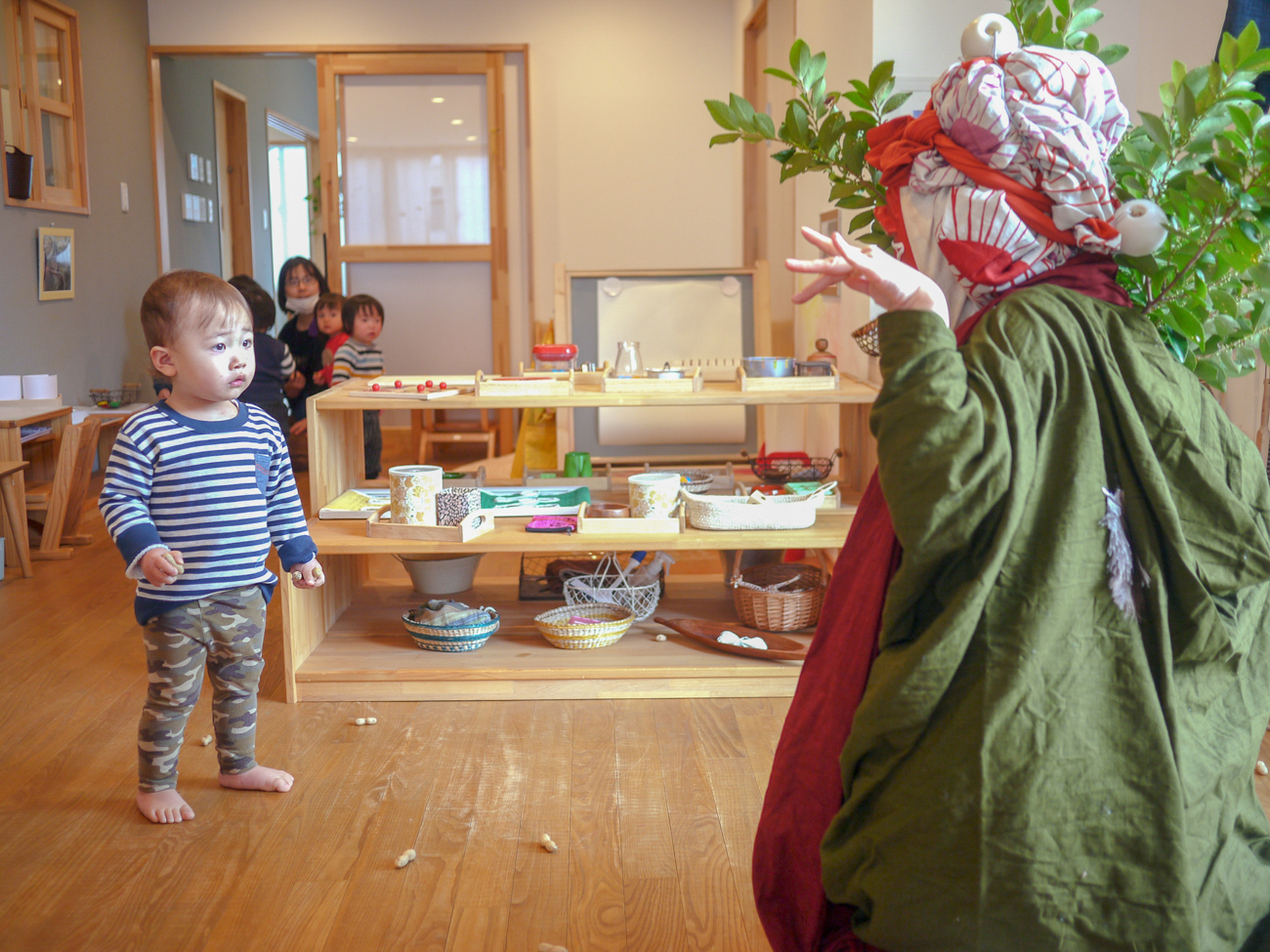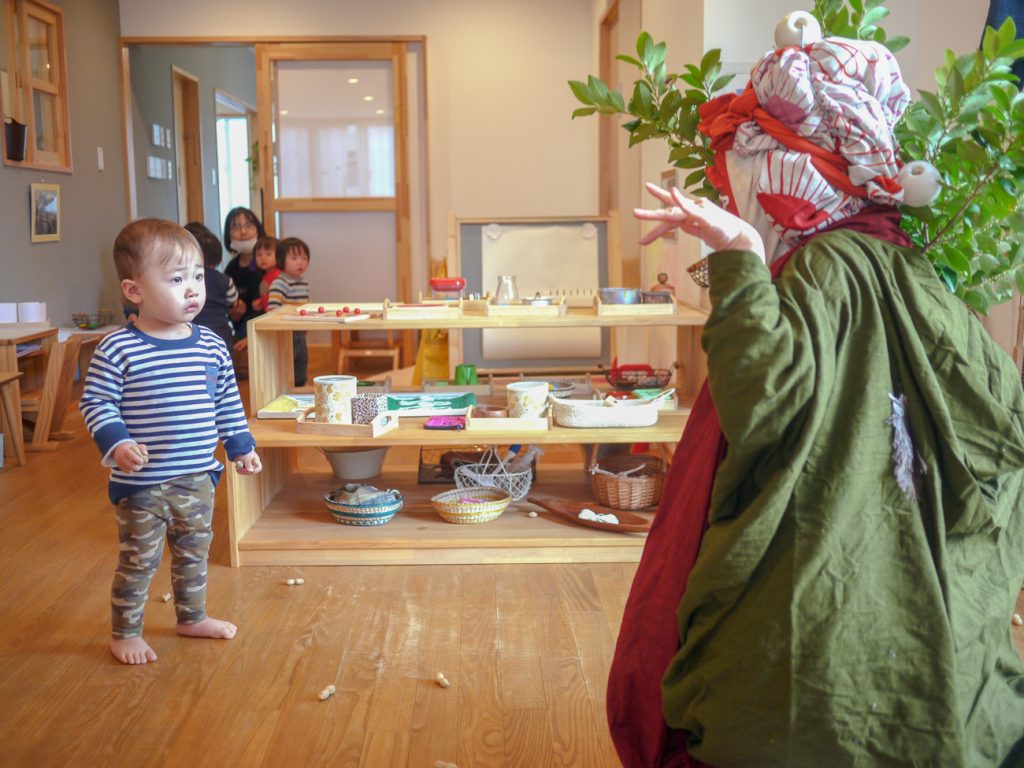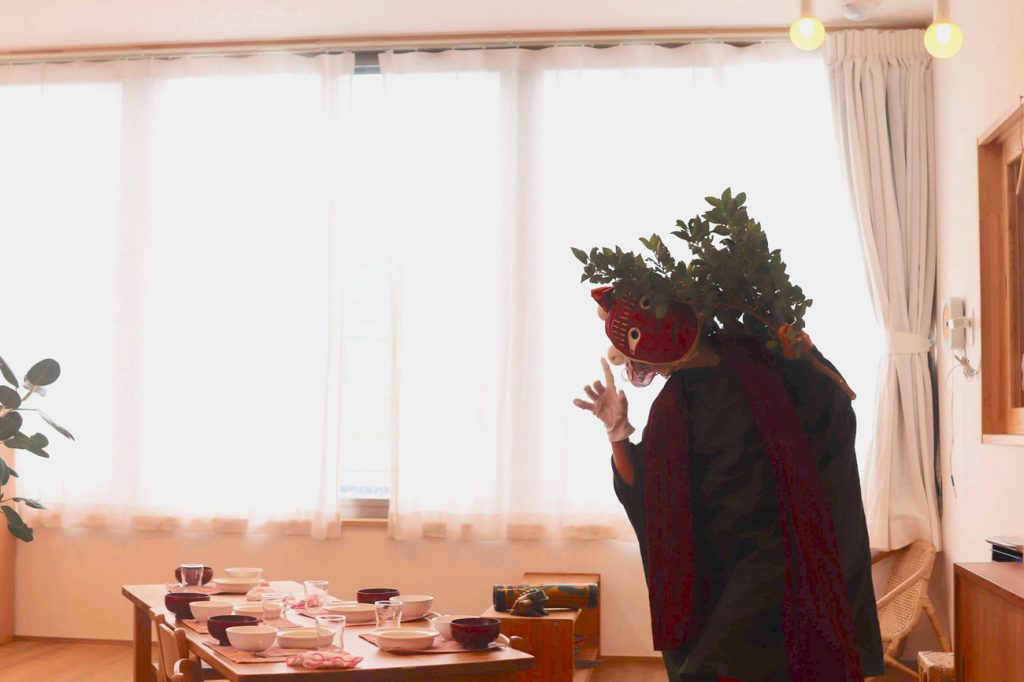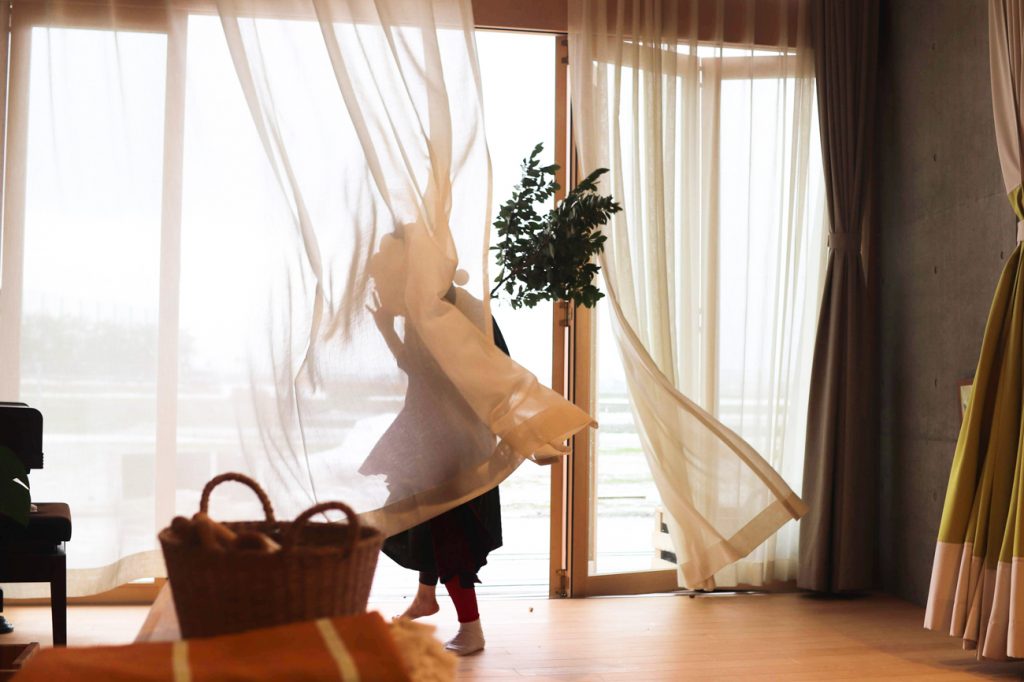
2019.03.03 Project “Setsubun” How was the red-faced guest received? Where did they go?
Text : Tomoko Nagao
On the day of the setsubun, a red-faced guest has come to Yamanoko. To me, the process in which how the day came about, and how it was received by the children were exactly like an art project.
Q1:How do we want to spend the day of “setsubun”? What is an Oni (demon)?
A month prior to the day of setsubun, the Yamanoko staff discussed how we want to welcome the day of setsubun. Last year, since there were only 1 to 2 year olds, we did not feel it necessary to scare them. But this year, there are 3 to 5 year olds. What do we want to do?
We knew that we wanted to invite Oni (demon). But what is it really? Are demons scary (or bad)? Not all demons are necessarily scary. Are all the narratives about bad/scary demons (and how we must throw beans at them to get rid of them) true ?If we were to get rid of them, shouldn’t we “sprinkle”(the appropriate verb for maku) the beans from bottom up instead of throwing at them? Perhaps demons aren’t scary, but are mere visitors from the spirit world to let us know about their existence?
From the moment we decided to welcome demons, there came many interesting questions. As we discussed amongst ourselves, many ideas were exchanged and the topic became more interesting.
Setsubun is written as “diving up the seasons” in Japanese. As it is expressed in the word, sankanshion (meaning, 3 cold days and 4 warm days), the season changes through the repetition of tension and relaxation. As the seasons transition, so do our bodies. Since there were many people passing away during these times of transition, perhaps people in the old days required some tension to get through the rough times. In this regard, demons aren’t scary but are mysterious entities from the spirit world that make people tense.
Finally, what we want to focus on the day of setsubun for the children is to feel that existence of the spirit world. This brought us to the notion that it is not necessary for them to feel fear or to welcome demons, but to encounter a mysterious entity.
Q2: How do we manifest a mysterious entity?
The next question we had was, how do we manifest a mysterious entity from the spirit world? With references from YOKAI NO SHIMA by Charles Fréger, nirai-kanai from Okinawa, marebito (the visitor) expressed by an anthropologist, Shinobu Orikuchi, and the notion that Japanese culture has always coexisted with the spirit world, we have shifted our thought of the spirit world from mere images in the our heads to actual forms.
How about we put a mysterious object in the room and leave it there for a while? But then perhaps children will panic. We concluded that it is best that we welcome the mysterious entity. What if someone dances? Everyday, there were ideas representing the spirit world from the staff such as a bell, a branch from the mountain, a mask from Korea, a glass float from the ocean, and mysterious movements. This was a collaborative process where everyone brought out their ideas by sharing their images.
On The Day
On 3rd of February, there is a nice breeze after the rain had stopped. When the children were done sprinkling beans while saying “demons out, fortunes in”, with the sound of the bells, there came “someone” with the red face. Children stare out to to the window. “Someone” went into each class, and after a while it went out like a warm wind.


In Fuki, Warabi, Urui and Kogomi class, there were children hysterically crying, calling out their moms, and children who stood frozen. When “someone” entered, the children must have felt that something strange has come therefore many of them huddled together, while some got close to “the guest” and inquisitively and curiously stared into their face as if they were enjoying their new encounters with the unknown.
In Akebi class, some children immediately ran to the bathroom with the door locked, some got close to them, saying “I am not scared!”, some trembled while hanging onto adults, and some stared at the guest somewhat dubiously. “Why aren’t they wearing sock on one foot?” “”It seems happy being blown in the wind” “They have a foot/hand. They must be human!” “Maybe they are exploring the room because it’s their first time?”. Many children who had the notion that setsubun = demons = scary! said, “it isn’t doing anything scary to us”.

When “someone” left, the children of Akebi said “what was that!?” with much excitement. What is a demon? NO, it didn’t have horns! What is Santa? Tengu? After a while, “someone” became to be called “the red-faced guest”. Will they come visit again? Maybe if we went to go look for them in Kune-Kune Yama (our favorite spot to play), they will be there! Let’s go look for them! With Sota’s suggestion, many children went outside to search for the red-faced guest. When we saw our friends at Yamanoko Home, they asked, “We are looking for the red-faced guest. Have you seen them? Do you know where they went?”. “It went to the direction of Spiber!”, the friends at Home said. When we ask the dads at Spiber, they said “the guest has not come here yet!”. From this encounter with the unknown, the children posed questions “where did they go?” “can we see them again?” “let’s go find them!”. We saw children taking actions with full of curiosity, wanting to find the truth with their own eyes.
To Encounter the Unknown
This project came about when the staff deeply explored and discussed a question. Furthermore, the children made it into their own adventure by exploring even further.
These sequences of actions are manifestation of the process in which Yamanoko created our own unique child-caring like an artwork, which merely started as a question.
“I take photos to magnify the quiet murmur of the nameless existence that is merely just born, completely unknown to others” -Harumichi Saito Exhibition “Nanimonoka (something/someone unknown)” (2015/3331 Arts Chiyoda/text from the exhibition)
As the photographer, Harumichi Saito, has said, the setsubun project cultivated and magnified the sensitivity for adults to feel the newly-born unknown together with children.













 PREV
PREV